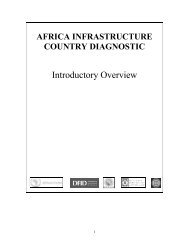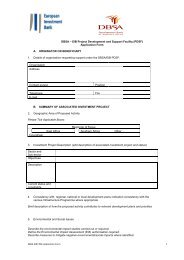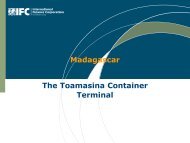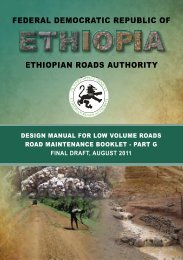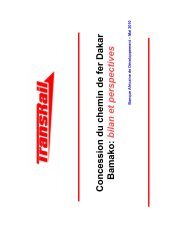Design-Manual-for-Low-Volume-Roads-Part-A
Design-Manual-for-Low-Volume-Roads-Part-A
Design-Manual-for-Low-Volume-Roads-Part-A
You also want an ePaper? Increase the reach of your titles
YUMPU automatically turns print PDFs into web optimized ePapers that Google loves.
A - Chapter 3 - 15<br />
Standard Technical Specifications: These will define the scope of the technical requirements of the<br />
contract, including the type and quality of materials and equipment, the standards of workmanship. The<br />
Standard Technical Specifications <strong>for</strong>m a separate volume in the ERA 2011 series and these capture most<br />
of the proposed interventions mentioned in this low volume road manual. The ERA Standard Technical<br />
Specifications includes in<strong>for</strong>mation on the <strong>for</strong>mat of Bill Items <strong>for</strong> the Bill of Quantities, on item coverage<br />
and the method of payment.<br />
<strong>Part</strong>icular Specifications: This is where any detailed technical requirements and specifications, and<br />
implementation mechanisms specific <strong>for</strong> the project should be clearly defined. The particular technical<br />
specification should also include any specifications and limitations on the freedom of choice <strong>for</strong> the<br />
contracting company related to the execution of works. <strong>Part</strong>icular technical specifications add further<br />
detail to complement or replace those stated in the Standard Technical Specifications.<br />
Bills of Quantities or Schedules of Rates: This should be linked by item number to the Standard<br />
Technical Specifications and to the <strong>Part</strong>icular Specifications; and is where the schedule of activities and<br />
estimated quantities are set out <strong>for</strong> the bidder to price.<br />
Drawings: Some standard detailed drawings may be applied directly <strong>for</strong> low volume roads works (eg<br />
cross-sections, standard culvert design and signage). Supplementary drawings, linked with the <strong>Part</strong>icular<br />
Specifications, may also be required where new, innovative or special approaches are included. Where<br />
trail bridges are included within the contract, as a complementary intervention, a separate volume of<br />
drawings is provided.<br />
Conditions of Contract: This includes standard provisions <strong>for</strong> execution of the contract and unless<br />
amended in the Conditions of <strong>Part</strong>icular Application, these will apply. It is anticipated <strong>for</strong> Major and<br />
Intermediate works projects that amendments may be required to reflect the desired approach <strong>for</strong> low<br />
volume road works. The simplified Conditions of contract with the standard Bidding Documents <strong>for</strong><br />
Minor and Micro works should not need amending.<br />
Conditions of <strong>Part</strong>icular Application: This is where any Provisions in the General Conditions of Contract<br />
may be amended, as required, to make them more appropriate to the requirements of the low volume<br />
road approach, including complementary interventions.<br />
In promoting small and medium scale enterprises; emergent contractors; employment intensive or<br />
labour-based works; and utilisation of intermediate equipment options, due consideration should be<br />
given to the clauses referring to Per<strong>for</strong>mance Security, Per<strong>for</strong>mance Program, Insurances, Cash Flow,<br />
Plant, Equipment & Workmanship, Payments, Retention and Advances, Price Adjustment and currency<br />
restrictions. There will be cases where the general conditions of contract may prevent, or work against,<br />
the small scale industry and these should be adjusted accordingly to promote competition and fairness<br />
to the emergent industry.<br />
Due consideration should also be given to strengthening clauses aimed at promoting sub-contracting/<br />
assignment; local employment and conditions (particularly <strong>for</strong> women); rights and insurances; and <strong>for</strong><br />
strengthening complementary interventions.<br />
User Guide’s: These documents will provide detailed guidelines to the design consultant on the<br />
preparation of the Works Bidding documents.<br />
Works Contract Evaluation: Recognition that the context of the works is using low volume road<br />
approaches must be included within the evaluation of bid process. The aim should be to ensure that<br />
the bidder confirms an understanding of the Client’s perception <strong>for</strong> implementation. If complementary<br />
intervention requirements are built into the prospective works, the evaluation should also ensure that the<br />
complementary interventions are fully understood.<br />
PART A: DESIGN STANDARD APPROACHES




